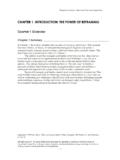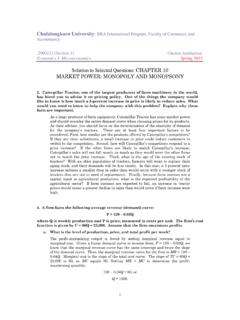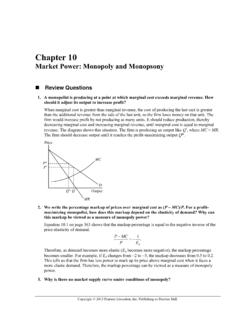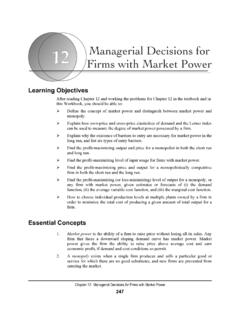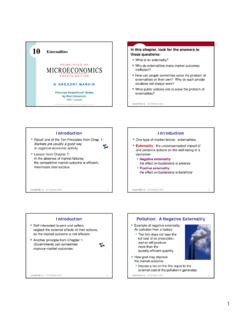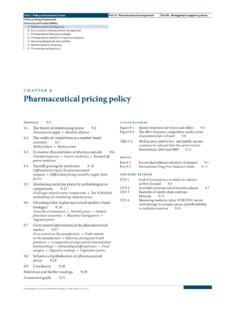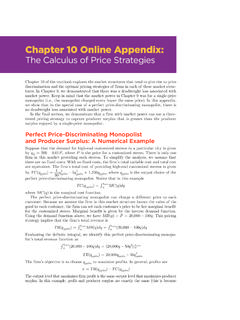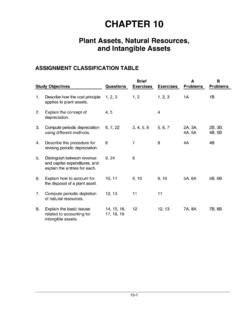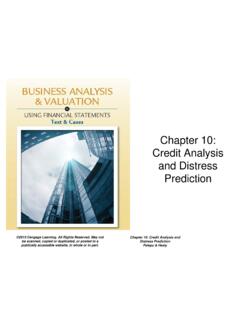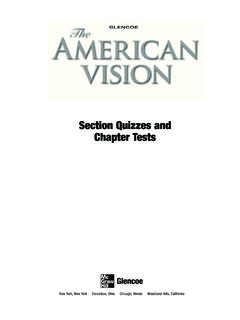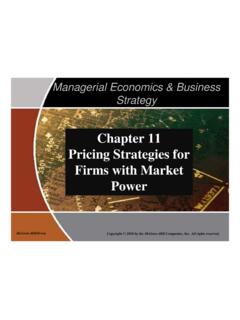Transcription of CHAPTER 9. POWER, CONFLICT, AND COALITIONS …
1 CHAPTER -by- CHAPTER Notes and Teaching SuggestionsCopyright 2003 by Joan V. Gallos and Jossey-Bass/A Wiley Company, 989 Market St., SanFrancisco, CA 94103 All rights reserved. No parts of this publication may be reproduced, stored in a retrievalsystem, or transmitted, in any form or by any means, electronic, mechanical, photocopying,recording, or otherwise, without the prior written permission of the 1 - CHAPTER 9. power , CONFLICT, AND COALITIONSCHAPTER 9 OVERVIEWC hapter 9 Summary_____In CHAPTER 9, the authors explore assumptions and ideas of the political perspective. Theyoutline:1. Key assumptions that underlie the Central elements of the frame ( power , politics, conflict, COALITIONS , and conflictinggoals).3. Sources of politics and political behavior in organizations (interdependence, enduringdifferences, scarce resources, and the distribution and exercise of power ).
2 The authors assert that managers and leaders are naive and romantic if they hope toeliminate politics in organizations. Instead, they need to understand and learn how tomanage political processes. The authors also examine:1. Organizations as COALITIONS , contrasting structural, human resource, and politicalperspectives on organizational goals;2. power and decision making, comparing structural, human resource, and politicaldefinitions of power , updating common understandings about sources of power , andillustrating decision-making processes between authority and partisans in socialarenas; and3. Conflict in organizations, viewing it politically as a natural and inevitable part oforganizational life and focusing on individual and group strategies for making thebest use of political CHAPTER concludes with an exploration of moral mazes and political dynamicsfostered by managerial needs for personal credibility and looking good.
3 The authorsraise questions about the moral implications of destructive politics and discuss ways ofcreating more constructive political dynamics in 9 Key Terms _____Authorities: In Gamson s analysis of political process, those who are entitled to makedecisions binding on others and who thus control the social system; they are therecipients or targets of influence and the agents or initiators of social Notes and Teaching SuggestionsCopyright 2003 by Joan V. Gallos and Jossey-Bass/A Wiley Company, 989 Market St., SanFrancisco, CA 94103 All rights reserved. No parts of this publication may be reproduced, stored in a retrievalsystem, or transmitted, in any form or by any means, electronic, mechanical, photocopying,recording, or otherwise, without the prior written permission of the 2 -Partisans: In Gamson s analysis of political process, those who cannot exert control in asocial system and so try to change the system by exerting bottom-up influence.
4 They arethe agents or initiators of influence and the targets or recipients of social system: System in which power is highly concentrated and everything istightly system: System in which power is diffuse and control is very conflict: Organizational conflict that occurs at interfaces betweendepartments or conflict: Organizational conflict that occurs at interfaces between levels of conflict: Organizational conflict that occurs at interfaces between groups withdifferent values, traditions, beliefs, and 9 Major Case Examples_____ The space shuttle Challenger Attempts to stop brand piracy in China Air France Political power vacuums in Eastern Europe and China Glasnost in the Soviet Union Covenant CorporationSUGGESTIONS FOR TEACHING CHAPTER 9 The central ideas in CHAPTER 9 revolve around power and politics.
5 Instructors can focuson:1. Exploring the content of the political Experiencing power , conflict, and political dynamics in methods appropriate for each approach are described in the sections that exercises keyed to the approaches appear in Student Exercises for CHAPTER 9, beginning on page Notes and Teaching SuggestionsCopyright 2003 by Joan V. Gallos and Jossey-Bass/A Wiley Company, 989 Market St., SanFrancisco, CA 94103 All rights reserved. No parts of this publication may be reproduced, stored in a retrievalsystem, or transmitted, in any form or by any means, electronic, mechanical, photocopying,recording, or otherwise, without the prior written permission of the 3 - CHAPTER 9: A Focus on the Content of the Political Frame_____Instructors can use this CHAPTER to examine the central elements of the politicalframe how politics, conflict, COALITIONS , conflicting goals, interdependence, enduringdifferences, scarce resources, and the distribution and exercise of power create alive andscreaming political jungles that often overwhelm 9: Cases Focusing on the Content of the Political FrameInstructors can explore the intricacies of the political frame through large- or small-groupcase analysis.
6 One place to begin is with the Challenger case, either as it appears in the text or in amore detailed version (for example, R. Marx, C. Stubbart, V. Traub, and , The NASA Space Shuttle Disaster: A Case Study, Journal ofManagement Case Studies, 1987, 3, 300 318, available from Elsevier SciencePublishing, 52 Vanderbilt Avenue, New York, 10017, reprint #0743-9296/87).The case is a rich source of discussion, and many students have memories of teaching materials for Challenger include detailed teaching notes byMarx, Stubbart, Traub, and Cavanaugh in the Journal of Management Case notes provide a four-frame analysis of the Challenger accident, ways to use thecase in the classroom, student assignments and worksheets, references and tables,suggestions for additional cases to explore similar issues, and a NASA consultingsimulation.
7 The NASA simulation creates four student consulting companies oneeach with a structural, a human resource, a political, and a symbolic focus hired toassist NASA in examining the complex causes of the Challenger are also instructor and student materials in Marx, Jick, and Frost sManagement Live: The Video Book (Prentice Hall, 1991). The instructor s materialsinclude a film segment on the Challenger explosion and its aftermath and teachingsuggestions for using the Challenger video. The student workbook has prefilm andpostfilm viewing assignments and supplementary Vaughn s book on the Challenger incident, The Challenger LaunchDecision: Risky Technology, Culture, and Deviance at NASA (Chicago: University ofChicago Press, 1995), is a classic in the organizations literature and could be used asa four-frame case threaded through a course.
8 A complementary case activity to use with the Challenger case is the Carter Racingcase. (See J. Brittain and S. Sitkin, Facts, Figures, and Organizational Decisions:Carter Racing and Quantitative Analysis in the Organizational Behavior Classroom, Organizational Behavior Teaching Review, 1989 90, 14[1], for complete informationabout the activity and its use in the classroom.) CHAPTER -by- CHAPTER Notes and Teaching SuggestionsCopyright 2003 by Joan V. Gallos and Jossey-Bass/A Wiley Company, 989 Market St., SanFrancisco, CA 94103 All rights reserved. No parts of this publication may be reproduced, stored in a retrievalsystem, or transmitted, in any form or by any means, electronic, mechanical, photocopying,recording, or otherwise, without the prior written permission of the 4 -In this case activity, students take the role of John Carter, head ofCarter Racing.
9 They must decide whether Carter should withdraw fromthe last boat race of the season with significant implications for sponsorsand crew morale because of information that inclement weather on raceday could produce an engine blowout. Students are given factualinformation to assess their choices but the facts are clouded by personalpreferences, feelings, group politics, and judgment calls on what the activity is powerful: Students see the impact of politics on seemingly unshakable facts. They have the opportunity to make a go no go decision in asituation very similar to Challenger. Students are sometimes startled to realize thattheir discussions are quite similar to those surrounding NASA s decision to number of other cases can be used to focus on more specific aspects of the politicalframe: power and influence: With West Point: The Cheating Incident ([A] [HBS 9-481-117]), instructors canwork with students to assess the major stakeholders, their interests, and theamount and sources of their power (this approach to political mapping isdiscussed in CHAPTER 10).
10 This can serve as a general model for diagnosing powerdynamics in organizations. Using this information, students can then speculateabout the politically viable options available to General Berry. Case C (HBS 9-482-006) explores the actual outcomes of the situation. British Steel Corporation: The Korf Contract (HBS 9-481-110) examines acomplex resource allocation process. Instructors can ask students to explore thevarious influence strategies chosen by decision makers. Two videotapes areavailable to supplement this case: an interview with Sir Monty Finniston, theformer chairman of British Steel, combined with a Granada Television tape ofevents leading up the critical decisions in the case (HBS 9-882-020) and anabridged version of Finniston s interview (HBS 9-882-521). Conflict: The Chattanooga Ice Cream Division (HBS 9-498-001) deals with functionalconflict among a company s senior managers, and the CEO s struggle to deal withthe resulting difficulties.
